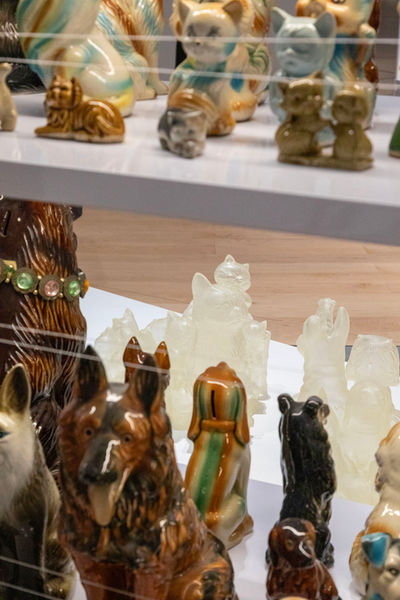Derived Pottery
Ceramic collection, resin, photo paper, video
Installation size
2025
IThe production era of these decorative ceramic figurines (ornaments) spans approximately from the 1940s to the 1990s, primarily (though not exclusively) crafted in the Yingge region. Compared to bowls, imitation antique ceramics, or (Miaoli) porcelain figurines, they have received relatively little attention in Taiwan’s ceramic tradition. This may be because these ceramic objects were largely outsourced and exported internationally at the time, resulting in a lack of local thematic and aesthetic connection. The craftsmanship tended to follow conventions with little innovation. Domestically, they were often used as game prizes, making it difficult for their perceived value to rise. Eventually, with industrial shifts in the 1990s, changing trends, and material replacements, these once-common ceramic figurines, found in household cabinets and bedside tables, gradually disappeared from collective memory.
When I first encountered these Taiwanese ceramic figurines around the millennium at flea markets, they occupied an ambiguous position—not quite old enough to be antiques yet possessing a certain nostalgic charm. Before understanding their value, I was drawn to their unique period ambiance and a sense of humorous misalignment. Historically, in East Asian ceramic traditions, independent sculptural works were relatively rare. Most of the classical ceramic pieces displayed in museums today serve practical purposes, such as tableware, vases, and stationery containers. Sculptures, when present, were often tied to functional roles, while purely decorative figurines were exceptions, typically religious statues or burial artifacts. In contrast, Western ceramic history developed quite differently, with ornamental ceramic sculptures (figurines) emerging frequently, showcasing remarkable craftsmanship and scale.
In the West, Meissen was the first to develop porcelain formulas, and its influence spread among high-end European ceramic manufacturers. Supported by aristocracy, these producers naturally emphasized elite tastes in their themes and aesthetics. Meanwhile, in Britain—the birthplace of the Industrial Revolution—the expansion of production capacity and lower costs, along with the empire’s global market, propelled Staffordshire, a once peripheral region, into a world-class ceramic hub. The rise of the middle class expanded the consumer base, shifting the primary market. Staffordshire potters initially mimicked traditional elite aesthetics but gradually tailored their creations to the tastes of their own social class. Their work closely reflected contemporary events and embraced unrestricted themes. In this way, Staffordshire ceramics democratized and popularized decorative figurines. Though today, these pieces may appear roughly crafted and somewhat clumsy—lacking the refined elegance typically associated with European ceramics—they nonetheless embody a sincere and unpretentious aesthetic, enriched by distinct British humor. Over time, Staffordshire figurines have transcended mere household decorations, as they preserve a snapshot of historical life, serving as a form of media that documents Victorian-era Britain.
As the global political and economic landscape was reshuffled after World War II, the ceramics industry began seeking lower-cost production bases worldwide. Post-reconstruction, Taiwan actively positioned itself as a global manufacturing hub, expanding its ceramic production while navigating its identity between various ceramic traditions. Ceramic figurines in Taiwan have always been a modern phenomenon, clearly adopting (learning, copying) Western craftsmanship, themes, and aesthetics. Their commercial nature and subtle symbolic language trace back to their predecessors in Europe and America, as well as earlier counterparts in the Far East and South America that shared similar industrial hierarchies. As these decorative figurines were transplanted to Taiwan, they evolved through differences in cost, technology, and local sensibilities. Over time, they absorbed deeper regional tastes, transforming into a variant—a "subtype"—of Western decorative figurines produced in a global South manufacturing base. The unique qualities of these Taiwanese ceramic figurines—aligned with their market positioning—reflect an attitude of casualness or adequacy, cuteness or poor taste, clumsy charm or rough craftsmanship. Now, filtered through the passage of time, these characteristics are recognized as part of a distinctive "Taiwanese aesthetic."
Looking through history, ceramic craftsmanship seems to exist within an ongoing cycle—imported from foreign traditions, imitated, localized, and then becoming the inspiration for the next wave of imitation. Perhaps ceramics, among all "civilized objects" created by humankind, possess a rare ability to transcend cultural boundaries, stacking and integrating multiple influences into their own traditions regardless of origin. These early Taiwanese ceramic figurines hint at Taiwan's connection to the world—often concealed in unexpected places. What we consider local (ethnic, national) characteristics may, in fact, be temporary results shaped by overlapping external forces.
(The exhibition was commission by New Taipei City Art Museum. The project was funded by National Culture and Arts Foundation)

Index (feathers, aquatics, forest, kingdom, farm, pets, fantasy, monument)
Resin
2025
The Mould for Moulds
Single channel 4K
11 min 42 sec
2025

toss.slot.crack
Photo paper
Size diversity
2019-2025
To view more of the series, please go to toss_slot_crack

















































